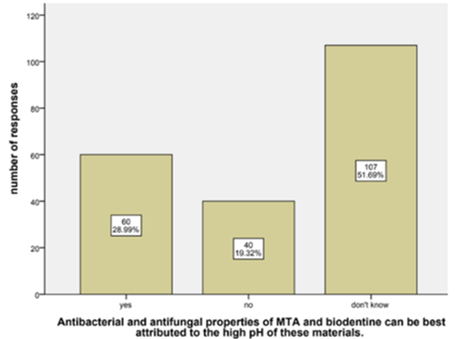Abstract
Direct pulp-capping is a procedure in which exposed vital pulp is treated by placing a dental material over dental pulp to maintain vitality and to facilitate reparative dentin formation. The most commonly used pulp-capping material for decades is calcium hydroxide. But due to a number of disadvantages, there is a need for an alternate ideal pulp capping material. Recently MTA and Biodentine have been suggested as promising candidates for use in direct pulp capping procedures. The aim of the present study is to evaluate the knowledge, attitude and practise of usage of MTA and biodentine as direct pulp capping agents. An online questionnaire consisting of 15 questions which included demographic details, and questions regarding their knowledge and awareness of direct pulp therapy and the properties of MTA and biodentine. Data was collected from filled questionnaires and analysed using SPSS software. Majority of the respondents (40.1%) chose calcium hydroxide as the material of choice for direct pulp capping and only 30% of the study population chose both MTA and biodentine as a direct pulp capping agent, which was statistically significant (p=0.000). 52% of the respondents were not aware of the major drawbacks of MTA. Knowledge regarding properties of biodentine in comparison to MTA was higher. Within the limits of the study, it shows that the knowledge in regard to the use of MTA and biodentine as direct pulp capping was poor despite recent studies showing a growing number of advantages over calcium hydroxide.
Full text article
Authors

This work is licensed under a Creative Commons Attribution-NonCommercial-NoDerivatives 4.0 International License.

